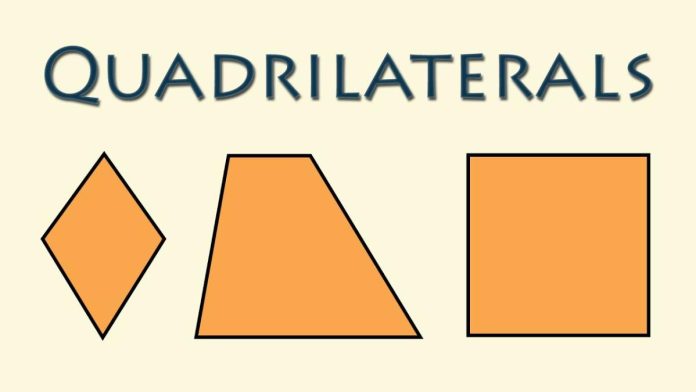In geometry, shapes are the building blocks of the universe. Among the many types of polygons, quadrilaterals are some of the most widely used and recognizable. From the screen of your smartphone to the pages of your notebook, quadrilaterals are everywhere. But what exactly is a quadrilateral? What are its different types, properties, and uses?
This article explores quadrilaterals in depth—covering definitions, classifications, mathematical properties, real-world applications, and more.
Table of Contents
Definition of a Quadrilateral
A quadrilateral is a polygon with four sides, four vertices (corners), and four angles. The term comes from the Latin words quadri (meaning “four”) and latus (meaning “side”).
In other words, any closed two-dimensional shape with four straight sides is considered a quadrilateral.
Basic Properties of a Quadrilateral
Every quadrilateral, regardless of its type, shares some fundamental properties:
- It has four sides (edges).
- It has four angles.
- The sum of the internal angles of a quadrilateral is always 360 degrees.
- The shape is closed—its sides connect end to end to form a boundary.
Classification of Quadrilaterals
Quadrilaterals are categorized into simple and complex types, and further into concave and convex based on their angles.
- Simple vs. Complex Quadrilaterals
- Simple Quadrilaterals: Sides only meet at vertices and don’t cross each other (e.g., square, rectangle).
- Complex Quadrilaterals (also called crossed quadrilaterals): One pair of opposite sides cross each other (e.g., bowtie or butterfly shape).
- Concave vs. Convex Quadrilaterals
- Convex Quadrilateral: All interior angles are less than 180°, and diagonals lie inside the shape.
- Concave Quadrilateral: One interior angle is greater than 180°, and at least one diagonal lies outside.
Types of Quadrilaterals (With Definitions & Properties)
Let’s look at the major types of quadrilaterals, most of which are parallelograms or trapezoids:
- Parallelogram
A quadrilateral with opposite sides that are parallel and equal in length.
Properties:
- Opposite angles are equal.
- Diagonals bisect each other.
- Adjacent angles are supplementary (add up to 180°).
Examples: Rhombus, rectangle, square
- Rectangle
A parallelogram with four right angles (90°).
Properties:
- Opposite sides are equal and parallel.
- All angles are right angles.
- Diagonals are equal and bisect each other.
- Square
A regular quadrilateral with four equal sides and four right angles.
Properties:
- All sides are equal.
- All angles are 90°.
- Diagonals are equal, bisect each other at 90°, and divide the square into two congruent isosceles right triangles.
- Rhombus
A parallelogram with all four sides equal in length, but angles are not necessarily 90°.
Properties:
- Opposite angles are equal.
- Diagonals bisect each other at 90° but are not necessarily equal.
- Diagonals bisect the angles.
- Trapezoid (US) / Trapezium (UK)
A quadrilateral with one pair of parallel sides.
Properties:
- May or may not have equal non-parallel sides.
- If the non-parallel sides are equal and angles are equal, it becomes an isosceles trapezoid.
- Kite
A quadrilateral with two pairs of adjacent sides that are equal.
Properties:
- One pair of opposite angles are equal.
- Diagonals intersect at right angles.
- One diagonal bisects the other.
Diagonals in Quadrilaterals
A diagonal is a line connecting opposite vertices.
- A quadrilateral has two diagonals.
- In some types (like squares and rectangles), diagonals are equal.
- In others (like rhombuses), diagonals are perpendicular but unequal.
Angle Sum Property
One of the fundamental theorems in geometry is the Angle Sum Property of Quadrilaterals:
The sum of the interior angles of any quadrilateral is always 360 degrees.
This can be proved by dividing the quadrilateral into two triangles. Since each triangle has 180°, the total is 180° × 2 = 360°.
Formulae Related to Quadrilaterals
Area Formulas
| Shape | Area Formula |
| Square | side² |
| Rectangle | length × width |
| Parallelogram | base × height |
| Trapezoid | ½ × (sum of parallel sides) × height |
| Rhombus | ½ × (diagonal₁ × diagonal₂) |
Perimeter Formulas
| Shape | Perimeter Formula |
| Square | 4 × side |
| Rectangle | 2 × (length + width) |
| Parallelogram | 2 × (base + side) |
| Trapezoid | sum of all sides |
| Rhombus | 4 × side |
Real-World Applications of Quadrilaterals
Quadrilaterals are not just mathematical concepts—they are everywhere around us:
- Architecture: Windows, doors, floors, and buildings often use squares, rectangles, and trapezoids.
- Engineering: Bridges and mechanical linkages often involve parallelograms and kites.
- Graphic Design: Screens, layouts, posters, and design grids use quadrilateral geometry.
- Land Surveying: Irregular quadrilaterals model land plots.
Fun Facts About Quadrilaterals
- A square is both a rectangle and a rhombus.
- All squares and rectangles are parallelograms, but not all parallelograms are squares or rectangles.
- The British use the term “trapezium” for what Americans call a “trapezoid” (and vice versa!).
- Quadrilaterals can be cyclic, meaning all their vertices lie on a circle (e.g., rectangles, isosceles trapezoids).
How to Identify a Quadrilateral
When given a shape, follow these steps to determine its type:
- Count the sides – Are there four?
- Check for parallel sides – Are any sides parallel or equal?
- Measure the angles – Are any right angles?
- Look at the diagonals – Are they equal? Do they bisect at 90°?
Based on this analysis, you can classify the quadrilateral correctly.
Conclusion
A quadrilateral is a foundational concept in geometry that encompasses a wide variety of shapes, from everyday rectangles and squares to complex kites and trapezoids. Understanding their properties helps us navigate fields like architecture, engineering, art, and design with better precision.
Whether you’re solving problems in a classroom or building models in the real world, knowledge of quadrilaterals gives you a solid edge in recognizing, analyzing, and utilizing geometric forms.

